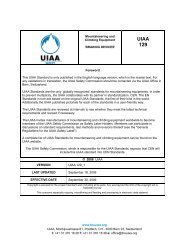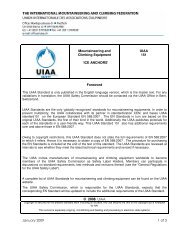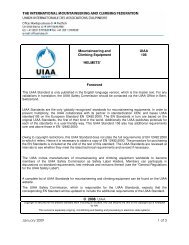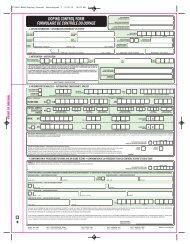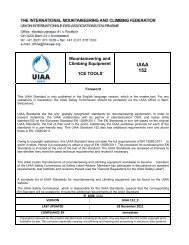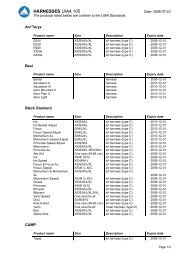Recommendations for via ferrata construction - UIAA
Recommendations for via ferrata construction - UIAA
Recommendations for via ferrata construction - UIAA
- No tags were found...
You also want an ePaper? Increase the reach of your titles
YUMPU automatically turns print PDFs into web optimized ePapers that Google loves.
RECOMMENDATION FOR THE CONSTRUCTION OF KLETTERSTEIGS (ALSO KNOWNAS VIA FERRATE) AND WIRE CABLE BELAY SYSTEMSProduced by the German Alpine Club and the Austrian Board of Mountain SafetyEditors: Chris Semmel und Florian Hellberg,German Alpine Club Safety Analysis UnitMunich, Germany, 2008© 2008Translated from the German by Dave Custer,American Alpine Club Delegate to the <strong>UIAA</strong> Safety Commission© 2009
Level of encroachmentThe installation of VF/KS equipment must be guided by the basic philosophy “As little as possibleand as much as is needed.” Elaborate installations, such as zip lines and suspension bridges,should not be added just to add them.QuarriesEspecially in the case of VF/KS located non-mountainous regions, installation in quarries mayprovide a legitimate alternative to natural cliff venues.Visitor levels/impactThe <strong>construction</strong> of a VF/KS can be employed <strong>for</strong> the purpose of controlling visitor levels so thatundeveloped regions are retain low visitation rates and those regions which are prepared withtourist infrastructure receive the majority of the tourist traffic. In undeveloped regions, nonotable tourist attractions may be created.Duration of useNew VF/KS should only be installed where it will be continually used because the installationcontinues to be an intrusion when it is not in use.1.6 Business ConsiderationsAs with every type of project, the <strong>construction</strong> of a VF/KS faces significant financial andorganizational challenges that must be addressed head on.Operations concept (business plan)An operations concept with the following detailed project planning elements must address:o Financial plano Supervision of the <strong>construction</strong>o Operation and maintenanceo Contractual Obligations (and financing) in regards to eventual decommissioning2 Technical Construction <strong>Recommendations</strong>Given the concept <strong>for</strong> the <strong>construction</strong> of a new VF/KS from scratch or the progressive upgradeof an existing installation, the <strong>construction</strong> details are of critical importance. For VF/KS, as withall climbing situations, proceeding entails danger.o The German Alpine Club safety analysis unit has conducted research to determine:o The loading during VF/KS useo The different types of VF/KS systemso The different types of anchors and connections appropriate to the different systemso The strength of safety equipmentThe intent of the German Alpine Club safety analysis is to produce a set of guidelines <strong>for</strong> the<strong>construction</strong> of “safe” VF/KS. In this section, the basic, technical results are presented <strong>for</strong> thedifferent components of different VF/KS system types:o Anchorso Wire cableo Progression aidso Other equipmenttranslation of the DAV recommendation <strong>for</strong> klettersteig <strong>construction</strong>pg 7 of 34draft of 4/1/2009, 12:27:50 PM
Based on these elements, further recommendations are offered <strong>for</strong> route selection, basic choice ofsystem with respect to repair and maintenance of existing installations. This section providesconcrete recommendations. The results of the research ought to be the basis of plans andcalculations. The practical recommendations ought to reduce the amount of repair andmaintenance work required of a VF/KS.2.1 Determining the path of a VF/KSWhether constructing a new VF/KS or upgrading an existing installation, a basic deliberation isthe determination of the route. Foremost, the considerations listed in 1.1.2 must be attended to.Then, the technical <strong>construction</strong> details of the chosen route must be evaluated in light of the routesurvey/inspection and the equipage. The route should be laid out such that the most difficultsection is close to the start, in order <strong>for</strong> the climber to evaluate the difficulty of the route andconsider retreat as an early option in the event that the difficulty of the climb or physicalconditioning has been misjudged. If it is not possible to arrange a difficult section at the start, it isrecommended that the crux sections have emergency exists that permit traversing around thecrux. Through clever route placement, the usual mountaineering dangers such as rock fall(especially from other parties) and thunder storms (amplified by VF/KS installations) can beob<strong>via</strong>ted. Often on VF/KS, one finds parties of varying speeds. The VF/KS should be laid outexplicitly to accommodate the overtaking/passing of parties—or otherwise deal with mismatchedparties. Route planning should address the following points:o Cables laid out <strong>for</strong> traversing or rising traverses are more susceptible to snow loadingthan vertical cableso Traverses permit the anchors and cables to be laid such that they are under overhangs,roofs, or buttresses where they are to some degree protected from the effects ofweathering, e.g. snow loading, icing, rainfall, etc.o Snow loading is higher in low angle sections than in steep sectionso Chimneys and gullies are to be avoided: rock fall endangers the VF/KS installation byripping the cables and anchors and endangers the climber; snow loading has a devastatingeffecto The wire cable should not contact the cliff (this is particularly true <strong>for</strong> suspension[bridge/cable] systems): on one hand there is the danger of damaging the cable throughrubbing on the cliff and on the other hand in the event that the climber must hang on thecable or use the cable <strong>for</strong> fall arrest, the cable’s contact with the cliff may interfere with thebelay systemo The danger of lightning strike can be minimized through simple precautions• Basically, keep the cables short• Don’t piece together cables• At the “connection points,” offset the anchors so that the belay points are as far apart aspossible (but no further apart than 1.2 m); this guideline <strong>for</strong> hanging cables provides aproblem free method <strong>for</strong> avoiding long lightning rodstranslation of the DAV recommendation <strong>for</strong> klettersteig <strong>construction</strong>pg 8 of 34draft of 4/1/2009, 12:27:50 PM
2.2 Loading of VF/KSTo design the anchors, cables, and cable connections <strong>for</strong> a VF/KS, it is vital to evaluation the loadsto which the system is subject. Basically, one must evaluate the working load and the maximumload.Working load means the load imposed on the VF/KS due to “normal” climber traffic. Thisincludes gripping and progression while climbing, down-climbing, and resting on the anchors.The VF/KS must be able to sustain this load indefinitely without incurring damage. Thus, theanchors cannot be made from materials that will de<strong>for</strong>m plastically in the anticipated loadingrange; nor should it be possible <strong>for</strong> the anchors to loosen or produce excess slack. In the event of afall, which is a rare event in VF/KS climbing, a significantly higher load will be applied to thestructure <strong>for</strong> a short period of time; this climber arrest load is defined as the maximum load.Plastic de<strong>for</strong>mation is tolerated in the event of the application of a maximum load; however,material failure, such as breaking an anchor, is not permitted to occur under maximum load.In addition to the working load and the maximum load, especially in winter or early spring, onemust contend with the snow load and rock fall impact which can easily add up to several tons.These loads must be addressed in the planning stage (through swapping out affected elements orroute choice), as it is unrealistic to build an entire installation that will be impervious to snowloads and rock fall impact.2.2.1 Unfavorable Amplification of Loads on VF/KSThe application of a load to a wire cable, as shown in Figure 1, results in an amplification of the<strong>for</strong>ce on the anchors due to the perpendicular redirection of the applied <strong>for</strong>ce along the directionof the loaded cable. The amplified anchor <strong>for</strong>ce is significant and must be taken into account,especially on traverses, but it is also relevant on rising traverses. The order of magnitude of the<strong>for</strong>ce amplification can be calculated and taken into account in the <strong>construction</strong> plans.Fig 1 Amplification of the load on the anchor points2.2.1.1 Estimation of loads by calculationThe loading of the anchors depends on the geometry of the anchor points and the spanning of thecable; the load can be calculated through the use of Equation 1. [Equation 1 is NOT correct in theversion on which this translation is based; thus, Equation 1 and the practical example below differfrom the original. The equations and values presented here in the translation are believed to becorrect]1 ⎛ x ⎞spanF_1 ⎜ ⎟anchor= Fappliedload+22⎝ ydroop⎠(1)The second term in Equation 1 represents the amplification factor.For example, when calculated according to Equation 1, a 4 m span that droops 20 cm under loadhas a <strong>for</strong>ce amplification of 5. A 30 cm droop results in an amplification of 3.4. Table 1 shows thecalculated amplification factors <strong>for</strong> a 4 m span <strong>for</strong> droops between 5 cm and 40 cm.Table 1 calculated amplification factors <strong>for</strong> a 4 m span <strong>for</strong> droops between 5 cm and 40 cmDroop (m) 0.05 0.1 0.15 0.2 0.25 0.3 0.35 0.4Amplification factor 20.0 10.0 6.7 5.0 4.0 3.4 2.9 2.52translation of the DAV recommendation <strong>for</strong> klettersteig <strong>construction</strong>pg 9 of 34draft of 4/1/2009, 12:27:50 PM
A practical example:Consider anchors separated by 3 m and a climber with a weight of 80 kg who hangs so that thecable droops in the range or 10 to 20 cm. This situation produces an amplification factor in therange of 7.5 to 3.8, according to Equation 1. Reducing spans and increasing droop has a positiveeffect on (reduces) the loading of the anchor points. The calculations have been tested againstexperimental results in a sample installation which was outfitted with multi-strand cable [Litzen-Drahtseil] and the calculations suffice only <strong>for</strong> a first order estimate.2.2.1.2 ExperimentSetupFig 2 Schematic of the anchor load measurement setupThe distance between the anchors amounted to 3.32 m. It was possible to control the tension in thecable with a winch and measure the magnitude of the <strong>for</strong>ce at the anchor point with a Dyna<strong>for</strong>®load cell (Figure 2). The load was applied at a point 1.78 m from anchor 1 and measured with aload cell. The length of the cable was regulated by means of a turnbuckle (see 2.5.3.4) installed inthe wire cable. Measurements were taken <strong>for</strong> two different <strong>for</strong>ces at different pre-loading levels:o A small loading (0.3 kN)o A high loading (6.6 kN)ResultsFig 3 Experimental results of measurements of anchor point <strong>for</strong>ceThe results are shown in Figure 3. The measured droop under load <strong>for</strong> the light pre-loadingranged from 10 cm to 30 cm and the droop of the highly pre-loaded setup ranged from 5 cm to15 cm.A comparison of the calculated and experimental data <strong>for</strong> the lightly pre-loaded cable shows thatan amplification factor of 3.5 is realistic. At the unusually high pre-loading levels, thetranslation of the DAV recommendation <strong>for</strong> klettersteig <strong>construction</strong>pg 10 of 34draft of 4/1/2009, 12:27:50 PM
amplification is at least 6. [This “amplification” may not a good measure of the effect of cableloading on pretensioned cables because it includes the pre-load tension in the amplification. Infact, the data suggests that the additional loading imposed on a tensioned cable is less than theloading imposed on an untensioned cable—a situation that is predicted by the vector addition ofthe pretension load and the applied climber load.] As a result of the testing:The tension in the cable is an important factor in determining the load on an anchor andsignificantly increases the <strong>for</strong>ce applied to the anchor.2.2.2 Loads exerted on a VF/KS by climbersAfter determining the <strong>for</strong>ce amplification, we sought to characterize the loading due to normalprogression along a VF/KS, <strong>for</strong> example hanging on cables and resting on the anchors. To do this,we dangled from a traversing cable and winched up the cable. The load imparted by the climberranged from 0.5 to 1.5 times body weight—an 80 kg climber would load an anchor in the range of0.4 to 1.2 kN. A nominal loading of 1 kN (100 daN) can be assumed.2.2.3 Definition of loadsProgression LoadA load that a VF/KS climber would exert in the manner outlined in 2.2.1.2; this load lies in therange of 0.5 to 1.5 times body weight <strong>for</strong> elements that are not significantly pre-loaded.Nominally, it can be taken to be 1.0 kN.For preloaded spans, expect a loading of 3.5 kN at the anchor point due to a progressing climber.Extra care must be taken <strong>for</strong> VF/KS with pre-loads as experiment suggests that a <strong>for</strong>ceamplification of 6 is possible in the event of maximal loading.The load due to climber progression must be born by the VF/KS without causing de<strong>for</strong>mationthat would lead to fatigue of the anchor points. The progression load <strong>for</strong> cable without pretensionis nominally 3.5 kN and <strong>for</strong> pretensioned cable it is 6 kN.Progression Load = 3.5 kN (<strong>for</strong> cable that is not pretensioned)Progression Load = 6.0 kN (<strong>for</strong> pretensioned cable)Maximum LoadOn rising traverses and steep sections, a fall arrested by deployment of a <strong>UIAA</strong>/CE EAS results ina maximum load of 6 kN, which is the maximum permitted by the standard (EN 958 & <strong>UIAA</strong>128). This 6 kN load must be taken as the maximum load that can be applied to steep sections.The anchor may undergo plastic de<strong>for</strong>mation under the application of loads in the range of themaximum load as the load duration in the plastic region is not long.Although loading of traversing sections produces <strong>for</strong>ce amplification (2.2.1), fall arrest on atraverse is not an issue as the EAS will not reach its threshold <strong>for</strong> deployment, In this situation,the maximum load of 3.5 kN <strong>for</strong> cables without pretension and 6 kN <strong>for</strong> pretensioned cablessuffices.Maximum Load = 6 kN (Intermediate anchor [Zwischenanker])Maximum Load = 6 kN (handrail anchor [Geländeranker] <strong>for</strong> pretensioned cable)Maximum Load = 3.5 kN (handrail anchor [Geländeranker] <strong>for</strong> cable without pretension)For the <strong>construction</strong> of VF/KS, these results distinguish between sections that must sustain highloads on account of elevation gain and the possibility of a fall and “handrail” sections that traverseand ob<strong>via</strong>te significant falls. The load bearing anchors can be divided into terminal anchors andintermediate anchors. These are different from the handrail anchors.translation of the DAV recommendation <strong>for</strong> klettersteig <strong>construction</strong>pg 11 of 34draft of 4/1/2009, 12:27:50 PM
2.3 Construction methods and anchoring systemsBasically, there are two different systems of VF/KS design:o The French system which employs loops to attach the cable to the anchors (Figures 4 & 6)o The eastern alps or classical system which allows the cable to run freely through theeyebolts; classical systems may employ tensioned or untensioned cable and the cable mayor may not be clamped at the anchors. (Figures 5 & 6).The influence of the VF/KS system type (French, classical, tensioned, untensioned) and the typesof anchors on the impact strength of the VF/KS carabiner has been the subject of a research ef<strong>for</strong>tby the German Alpine Club.The results of this research indicate that the type of <strong>construction</strong> has significant effect on theloads imparted both to the anchors and to the VF/KS belay carabiners.Fig 4 The French system with cable loopsin eyeboltsFig 5 Eastern alps/classical system withtensioned or untensioned cable througheyebolts, possibly clampedtranslation of the DAV recommendation <strong>for</strong> klettersteig <strong>construction</strong>pg 12 of 34draft of 4/1/2009, 12:27:50 PM
The French system with cableloops in eyeboltsFig 6 Different <strong>construction</strong> systemsThe eastern alps system withanchor clamps and a taut butuntensioned cableThe eastern alp system with thetensioned cable running freelythrough the eyebolt2.4 Anchoring systems <strong>for</strong> wire cablesSome attachment is needed to fasten steel cable to the cliff. In the following, such attachment isreferred to as “anchor.” Anchors, in combination with cable, are the central <strong>construction</strong> elementsof a VF/KS. In this section the different considerations of the selection of anchor types, their<strong>construction</strong> (material and geometry) as well as their installation are covered in detail. To serve asexamples, calculations and experimental measurements are provided by the German Alpine Club.2.4.1 Anchor typesIn general, there are two categories of anchors: eye bolts and clamp anchors.Eyebolts: In eyebolts, the cable is freely threaded through the eye and is not constrained and canthus move freely. Rebar and ribbing of the eye is to be shunned. The eyes must be smooth andfree of burrs to minimize damage to the cableClamp Anchors: In contrast to eyebolts, the cable in a clamp anchor (flag anchor/flat clampanchor [Fahnenanker] or bracket clamp/U-clamp anchor [Bügelklemmanker]) is constrained bythe clamp. For end anchors, eyebolts or glue-ins are used. Alternatively, the cable ends can beglued into the cliff an appropriate distance (compare also 2.4.3.1). Cable diameter determines thedepth of the hole required <strong>for</strong> the cable clamp anchor.translation of the DAV recommendation <strong>for</strong> klettersteig <strong>construction</strong>pg 13 of 34draft of 4/1/2009, 12:27:50 PM
Description of anchors:1 32 mm U-clamp anchor 2 20 mm U-clamp anchor 3 20 mm eyebolt (mfr. Schiestl) 4 16 mm angledeyebolt 5 16 mm eyeboltFig 7 Types of anchors:The use of industrial grade anchors is strongly recommended. Do-it-yourself weldingintroduces an unnecessary source of danger.The ability of the anchor to sustain loads depends on the anchor design and the type of VF/KS<strong>construction</strong>. Accordingly, the German Alpine Club has measured the semi-static breakingstrength of different types of VF/KS carabiners. We tested eyebolts and U-clamp anchors (smooth<strong>for</strong>ged clamp anchors), straight and angled, in untensioned and tensioned systems as well as theFrench loop <strong>construction</strong>. For flat plate clamp anchors, the manufacturing cost was a problemdue to reduced values from embrittlement during welding and <strong>for</strong> this reason they have beenomitted from this study.2.4.1.1 Investigation of anchor systemsIn this investigation, the unfavorable loading of VF/KS carabiners was undertaken in order todetermine the influence of the system on the results. Tested were the U-clamp anchor with14 mm, lightly tensioned cable and 12 mm pretensioned cable.Determining the most unfavorable loading directionThe most unfavorable loading direction:In this investigation, a loading direction perpendicular to the loading axis (carabiner spine axis) isconsidered the worst case loading direction from which trends can be extrapolated. The results ofthe tests of different pretensions shows that a lightly pretensioned system allows some play in thecable so that the carabiner is not truly loaded in a bending mode; similarly, a very high varience inthe peak load occurs in pretensioned systems with a resulting, alarmingly low strength.translation of the DAV recommendation <strong>for</strong> klettersteig <strong>construction</strong>pg 14 of 34draft of 4/1/2009, 12:27:50 PM
Fig 8 Classical/east-alps VF/KS system with eyebolts and pretensioned cable (the VF/KS carabineris loaded perpendicular to the spine axis)Carabiner strength according to different anchor types and cable systemsThe further investigation of the carabiner strength according to different anchor types and cablesystems was carried out in the unfavorable loading configuration to the degree that this waspossible (see Fig. 8). The experiment matrix took into account the difference between eyeboltsand U-clamp bolts, straight and angled, and the French loop <strong>construction</strong> system and the classicalsystem with different cable pretensionings. The results show an average carabiner strength of19.0 kN <strong>for</strong> untensioned cable and 14.6 kN <strong>for</strong> tensioned cable, whereby alarming rupture valuesoccurred in the range of 6 kN.Discussion of resultso The strength reduction of carabiners due to bending loading at the anchor is not as big adeal as initially thoughto The effects of the cable outweigh those of the anchor type; there is no significantdifference in carabiner strength due to any anchor type.o The important aspect of loading is a small amount of pretension (French system orclassical system without pretensionings); pretensioned cable can significantly reduce thebreaking strength of the carabiner.o The differences in carabiner strength between the French system and the unpretensionedclassical system are negligible, and the high variance is not practicallyrelevant.Conclusions of the anchor system investigation:o Untensioned or lightly tensioned systems are recommended—<strong>construction</strong> according tothe French system or the classical/east alp system with U-clamp anchors and lighttensioning.o The classical system with pretensioned cables in eyebolts is not recommendedtranslation of the DAV recommendation <strong>for</strong> klettersteig <strong>construction</strong>pg 15 of 34draft of 4/1/2009, 12:27:50 PM
2.4.2 Appropriate materials <strong>for</strong> anchorsThe materials appropriate <strong>for</strong> use in cable anchors are rebar steels that con<strong>for</strong>m to EN DIN 10080(Standard <strong>for</strong> ribbed <strong>construction</strong> steel [rebar], the ribbing is important <strong>for</strong> the bonding agent[glue]) quality class 500S (high strength and weldability). Further, a protective corrosion coatingis recommended, <strong>for</strong> example Zinc or Chrome—otherwise the cliff fills up with rusty nubs. Theuse of expensive stainless steel is only important <strong>for</strong> anchors that are not subject to snow loadingor rock fall and thus do not need to be swapped out. In most cases, oversizing the anchor is not anacceptable method of protecting against corrosion.2.4.3 Definition of anchor and anchor dimensionsIn general, there is a distinction between high strength sections, <strong>for</strong> example anchor points ofvertical sections subject to the possibility of fall arrest, and traversing [handrail] sections. The<strong>for</strong>ce requirements are further distinguished <strong>for</strong> end anchors and intermediate anchors. Incontrast, the traversing anchors are distinct.The three anchor classes:1. End anchor:These are all the anchors that fix the ends of the cables. As the failure of an end anchor wouldhave fatal consequences, and they are often used as belay stance anchors, the climbing anchorstandard is used: a breaking strength of at least 25 kN in the radial direction and 15 kN in theaxial direction.2. Intermediate anchor:These are all the anchors that lie between end anchors in high strength sections.3. Traversing anchor:Traversing anchors are anchors in traverses where there is no possibility of falling any distance.They can be found between end anchors, <strong>for</strong> example between two corner anchors. Theimportant characteristic is that no fall arrest loads can be applied. Further, in order to preventunfavorable leverage of progression loads, a thinner (handrail) cable can be used.Table 2 Anchor definitions & requirementsName Characteristics RatingHandrailanchorNo free fall is possible and thus redundancy isnot needed3.5 kN <strong>for</strong> progression loads, presumingthe cables are not pretensionedIntermediate Redundant system (U-clamp anchor)3.5 kN <strong>for</strong> progression loadsAnchor Non-redundant system (eyebolt) 6 kN <strong>for</strong> progression loadsEnd anchorAccording the climbing 25 kN radial load 25 kN pull to failureanchor standard 15 kN axial load 15 kN pull to failureFurther clarification:The use of U-clamp anchors, <strong>for</strong> example with the French system, allows the cable to be fixed toeach anchor point. In the event of a fall, should the loading result in the failure of an anchor, thenext anchor can take the load. This system is more or less redundant against anchor failure. Thus,such systems can be constructed with a nominal progression load of 3.5 kN without anyadditional safety factor.When using eyebolts through which the cable is freely threaded, each anchor must be sufficientlystrong to be able to sustain a fall arrest. A load of 6 kN must be withstood without de<strong>for</strong>mationsufficient to damage the material. Further, the loading angle <strong>for</strong> pretensioned systems issignificantly unfavorable (see 2.2.1) and thus the importance <strong>for</strong> tensioned cables that there are noburrs in the eyebolts that lead to degradation of the cable.translation of the DAV recommendation <strong>for</strong> klettersteig <strong>construction</strong>pg 16 of 34draft of 4/1/2009, 12:27:50 PM
The pretensioning should be reduced to a maximum of 4 kN.For all high load anchors, the climbing anchor requirement is recommended, 25 kN radial and15 kN axial. The <strong>for</strong>ce application point occurs at the contact between the cable and anchor,whether eyebolt or clamp (see Fig. 9). At this point, a progression load should not cause plasticde<strong>for</strong>mation that could lead to anchor failure.Fig 9 The <strong>for</strong>ce application point lies at the contact between the cable and the anchorIn principle, the sizing of anchors is done according to the anchor classification outlined in 2.4.3: endanchors, intermediate anchors, and traversing anchors.2.4.3.1 End anchorsFundamentally, end anchors lack redundancy. To counter this lack of redundancy, the endanchor requires a fundamentally higher safety factor. They should be sized according to theintermediate anchors of a pretensioned system (6 kN) so that material degradation does not resultfrom plastic de<strong>for</strong>mation due to fall arrest. This situation requires that the anchor be mountedflush with the wall to reduce the lever arm (Fig. 10). Further, end anchors must take on the ratingof climbing anchors: 25 kN radial & 15 kN axial.Fig 10 End anchoring with minimal lever arm (left & right); the direct fixing of the cable to the cliff shownin the middle figure is indeed sufficient though obviously the cable cannot easily by swapped out.translation of the DAV recommendation <strong>for</strong> klettersteig <strong>construction</strong>pg 17 of 34draft of 4/1/2009, 12:27:50 PM
2.4.4 Hole depth and fixing techniqueThere are two different methods used to fix the anchor to the cliff:o hammered in press-fit anchorso glue-in anchorsFor the press-fits, friction bonds the anchor to a precisely dimensioned hole. For glue-ins, abonding agent is used that can handle the loading, and the recommended installation instructionsdictate a 2-3 mm gap around the anchor.Investigation of anchor fixing techniquesThe German Alpine Club has undertaken an investigation of anchor fixing techniques:Press-fit: 32 mm diameter anchors were driven into 32 mm boreholesGlue-ins: Using a bonding agent, 16 mm anchors were glued in 20 mm holes and 20 mm anchorswere glued in 25mm holes.Experiment setup:The pullout strength was measured in the axial direction with a hydraulic tensile tester(Figure 14).Fig 14 Axial pull of an anchor with the tensile testertranslation of the DAV recommendation <strong>for</strong> klettersteig <strong>construction</strong>pg 21 of 34draft of 4/1/2009, 12:27:50 PM
ResultsThe pullout strength of the press-fit (32 mm diameter & 200 mm insertion depth):o Measurement 1: 32 kNo Measurement 2: 32 kNThe pullout strength of the glue-in bonding agent:o Measurement 1: 40 kN (16 mm diameter & 200 mm insertion depth):o Measurement 2: carabiner failure at 32 kN (20 mm diameter & 200 mm insertion depth)For press-fitting, whether the anchor is surrounded by bonding agent is not a deciding factor.The only effect of bonding age use is the requisite widening of the bore. For anchor fixing oncliffs, both glue-in and press-fit fixing techniques are appropriate. Inappropriate techniquesinclude the use of <strong>construction</strong> cement or fast setting cement because cyclic loading willeventually fracture the cement and the anchor will fail.<strong>Recommendations</strong> <strong>for</strong> insertion depthThe insertion depth depends on diameter and anchor type (stand-off distance) as well as the rockquality (Table 5).Table 5 Insertion depthGood rock qualityPoor rock qualityLever arm of the anchor: With lever arm Without lever arm With lever arm Without lever armSoft stone (e.g. sandstone) 20-30 cm 15-20 cm 30-50 cm 20-40 cmMedium hard or hard stone15-25 cm 10-20 cm 25-40 cm 20-30 cm(limestone and igneous rock)For bonding agents, recommended are all industrial/<strong>construction</strong> 2-component epoxy orpolyester based agents approved <strong>for</strong> the loading range.Recommendation <strong>for</strong> hole diameterPress-fitting: For friction based anchoring, the hole diameter must be that of the anchor.Glue-ins: For a glue-in, a 2-3 mm space between the anchor and the hole is appropriate.2.4.5 Anchor SpacingThe distance between anchors in high-<strong>for</strong>ce sections should be less than 4 meters, measured as avertical distance (Figure 15).For end anchors and the first intermediate anchor, it is recommended to reduce the spacingfurther (as shown in Figure 15) to prevent the danger of groundfall.translation of the DAV recommendation <strong>for</strong> klettersteig <strong>construction</strong>pg 22 of 34draft of 4/1/2009, 12:27:50 PM
Fig 15 Schematic diagram of a fall on a VF/KS. The separation of anchors should not exceed 4 m, andgroundfall should be prevented.In low-angle sections, the anchor spacing should not exceed 5 meters. For rope spans overchasms, suspension bridges, or zip-line installations, the spacing should not exceed that of 10times the maximum sag under an 80 kg load placed at the midpoint of the span.2.4.6 Construction implementationFor the <strong>construction</strong> and upgrade of a VF/KS, it is important to use the same anchor fixturesthroughout the installation. Only the end anchors can differ from the rest. This allows the quickswapping of “matching” anchors and simplifies repairs.Eyebolts:In order to use a cable eye stiffener, one must correctly dimension the eye to be 3-5 mm widerthan the cable diameter. If the anchor eye is too large, the cable will rub eventually wear through(Figure 18). For end anchors, it is practical to use larger eyes in order to accommodate two cables,possibly with eye stiffeners.At intermediate anchors, it is recommended that clamp anchors be used to constrain cablerubbing, as the anchors are degraded by the contact with the cable (see Figure 17) and a wearingthrough of the anchor eye is always possible. It is best to avoid ribs or burrs in the eye, whichshould be smooth to protect against cable degradation (see Figure 16).Different cable diameters require different anchor dimensions and clamping geometries.Provide pictures of no-goes, <strong>for</strong> example, short cuts etc.translation of the DAV recommendation <strong>for</strong> klettersteig <strong>construction</strong>pg 23 of 34draft of 4/1/2009, 12:27:50 PM
Fig 16 Rebar eyebolt in a classic east-alps tensioned installation. The inner surface of the eyeboltis smooth and free of burrs.Fig 17 Cable clamps on either side of an intermediate anchor limit wear.Fig 18 Friction wear of eyebolts.translation of the DAV recommendation <strong>for</strong> klettersteig <strong>construction</strong>pg 24 of 34draft of 4/1/2009, 12:27:50 PM
2.5 Wire cableCables, along with the anchor points, comprise the most important parts of the VF/KS. In thissection, the selection of cable and its dimensions according to the connection opportunities isdescribed. Later, the resulting implications <strong>for</strong> repair and maintenance are described (-> 2.7). Afurther aspect that is address in 2.5.3.6 is that of rubber bands.2.5.1 Definition of cable typesMany types of cable are available on the market, but of course all are not appropriate <strong>for</strong> use onVF/KS. The main categories of cable are spiral cable [Spiralseil] and stranded cable [“laced cable”:Litzenseil]; only the stranded cable is appropriate <strong>for</strong> VF/KS. Spiral cable con<strong>for</strong>ming to DIN3052 and DIN 3053 is quite stiff and slippery. Further, in spiral cable <strong>construction</strong> it is difficult toprevent the breakage of individual wires (-> 2.7.1.1). Because the individual wires of the spiralcable that lie on the outside surface do so <strong>for</strong> the entire length of the cable, any outer wire thatbreaks will unravel the entire length of the cable unlike the stranded cable in which the individualwires unravel around the strand axis and into the middle of the cable.Stranded cable con<strong>for</strong>ming to EN 12385-4 (<strong>for</strong> example, DIN 3060: 6x19 = 6 strands, each with 19wires and DIN 3055: 6x7 = 6 strands, each with 7 wires) are relatively flexible and graspable andare recommended <strong>for</strong> VF/KS <strong>construction</strong> and are only a little more expensive that the spiral<strong>construction</strong> cables. In the <strong>construction</strong> of stranded cables a single wire in the strand will alternatebetween the inside and outside of the cable (the <strong>construction</strong> of stranded cable is shown in Figure19). Thus, the severing of a single wire is compartmentalized and the unraveling is preventedwithout recourse to the use of rubber bands (-> 2.7.1.1).Spiral ConstructionStranded ConstructionDIN 3052 DIN 3053 DIN 3055Not RecommendedRecommendedFig 19 Cable types according to DINStranded cable is available in different materials <strong>for</strong> different applications. Only materials withlow susceptibility to acidity that dry quickly are recommended.Steel cable is available with different diameters of the individual wires. The choice of wirediameter is a trade-off between handling (thick wires result in stiff, slippery cable) on one handand cable degradation (thin wires result in high corrosion rates and susceptibility to mechanicaldamage) on the other hand. The DIN 3060 or DIN 3055 stranded cable represent a reasonablecompromise. Important to cable selection is the corrosion resistance. (Hot-dipped) galvanizationis recommended. The use of stainless steel cable may not be called <strong>for</strong> on account of its high priceand the need <strong>for</strong> swapping cables out, especially in sections subject to snow loading and rock fall.For other special plastic cable coating options available on the market, the samerecommendations apply as to rubber bands (-> 2.5.3.6); these coating allow moisture to collecttranslation of the DAV recommendation <strong>for</strong> klettersteig <strong>construction</strong>pg 25 of 34draft of 4/1/2009, 12:27:50 PM
etween the coating and the steel and promote corrosion. PVC, the most common plastic, hasvery low tolerance <strong>for</strong> mechanical damage and fatigue, and thus such coatings represent anadditional failure mechanism. Often the damaged spot is patched with a rubber band and thecorrosion problem is exacerbated. Further, coated cables are quite expensive.2.5.2 Cable dimensionsFundamentally, the VF/KS should be constructed with a single diameter of cable on the groundsthat the single diameter determines the anchor geometry and the sizing of all additional equipage,including eye grommets, shackles, turnbuckles, etc. For the dimensioning of the cable thickness,differences in section difficulty can be taken into account (handrail vs. high strength sections).The recommended cable diameters are shown in Table 6.Table 6 Recommended minimum cable diameter <strong>for</strong> different VF/KS sectionsType of section Recommended minimum diameter Cable standardHandrail 8 mm EN 12385-4 (6x7)High load sections 12-18 mm EN 12385-4 (6x19)2.5.3 Cable fasteningSlack cable is only recommended when it is fixed to each anchor point. When using eyebolts andfree running cable, the cable should be tensioned so that an 80 kg loading does not cause the cableto wear in the eyes.In general, the pretension should be limited to 4 kN. For tensioned cable, the contact with the cliffmust be kept to a minimum on account of both accelerated abrasion of the cable due to rubbingand difficulties imposed on the climber, both <strong>for</strong> moving the belay along the cable and in theevent a fall when the contact point may interfere with EAS deployment.In general, it is preferable to fix the cable to every anchor.2.5.3.1 Cable clampingFor the <strong>construction</strong> of VF/KS, only cable clamps tested according to EN 134M-5 (DIN 1142)should be used. For the securing of end anchors, three clamps are in order. Here the U-clampsmust be placed on an unloaded cable section downstream of the loaded cable ends. The firstclamps should be installed directly behind the eye grommet/stiffener to prevent the ripping out ofthe grommet. Freely protruding grommets present a risk of injury and can be mistaken as anchorpoints (two such fatal accidents are known). The minimum separation between the clamps is theclamp breadth (Figure 20).translation of the DAV recommendation <strong>for</strong> klettersteig <strong>construction</strong>pg 26 of 34draft of 4/1/2009, 12:27:50 PM
Fig 20 Cable clamps <strong>for</strong> fastening the cable to an end anchor (the clamps must be applied to an unloadedsection of cable). “The minimum separation between clamps = the clamp width”Fig 21 Eye grommet/stiffener in a cable loop (the first clamp must be located directly behind the grommetto prevent it from ripping out)Further, the adoption of bolt protection caps is recommended to reduce the danger of injury. Thisis required along the full length of the threaded bolt section and can be easily produced at homeor in a workshop. Without such protector caps, one can seriously scrape on the screw threads andnuts. It is a well known accident in which VF/KS climbers incur serious lacerations that could bereduced with protector caps.2.5.3.2 Grommets/eye stiffenersOften a grommet is used to fasten a cable loop to an end achor as shown in Figure 20/21. Here itis important to use the correctly sized grommet. The grommet should protect the cable from theanchor point both by providing mechanical protection and by reducing fatigue by providing aconstant bend radius under loading that protects against nicks in the cable.For assembly, open, unwelded grommets are employed because they can be threaded through theeyes. For bending the grommet, a special tool is required and is recommended <strong>for</strong> preparation athome or in the workshop according to the easiest good plan. The use of grommets entails thedanger that the grommet will separate from the cable loop in which case it can be misused as ananchor point (two fatal incidences of this accident type are known).2.5.3.3 Shackles and quick linksAt different places, <strong>for</strong> example with the use of turnbuckles with eyebolts, quick links must beemployed. Basically, quick links are not recommended as they reduce the belay distance.Galvanized quick links that con<strong>for</strong>m to EN DIN 82101, Form A, which is also satisfied by thecarabiner standard EN354, should be used. Quick links are always subject to coming unscrewedwhich must be prevented by: 1) denting the threads with a hammer and punch or 2) threadingand tensioning a safety wire through a hole drilled in the threads.Insert image of measure against unscrewing!translation of the DAV recommendation <strong>for</strong> klettersteig <strong>construction</strong>pg 27 of 34draft of 4/1/2009, 12:27:50 PM
2.5.3.4 TurnbucklesTurnbuckles are important <strong>for</strong> the classical, east-alps <strong>construction</strong> method with tensioned cablethrough eyebolts. Turnbuckles available on the market fall in two different categories: tubeturnbuckles and open turnbuckles [Rohrspannschloss und offenes Spannschloss].Tube turnbuckles according to standard EN DIN 1478 (Figure 22, top) are constructed ofcorrosion resistant steel and are recommended (and expensive). Of course moisture can collect inthe tube and lead to enhanced corrosion that cannot be perceived from the outside.Open turnbuckles according to standard EN DIN 1480 (Figure 22, bottom) can be purchasedwith different mounting connections:o <strong>for</strong>k mounting (cotter pin mounted) [Gabelbefestigung] [not shown]o eye mounting [“ear mounting” Ösenbefestigung] [see Figure 22]o hook mounting (not recommended !) [see Figure 22]Of these types, only the <strong>for</strong>k/cotter pin mounting is recommended.Fig 22 Turnbuckles <strong>for</strong> wire cable (above, tube turnbuckle with eye mounting; below open turnbuckle withhook (left) and eye mounting—not recommended)Hook mounting is generally not secure enough <strong>for</strong> use in VF/KS <strong>construction</strong>. With eyemounting, there is the problem of reduced belay spans on account of the inherent extensionintroduced by quick link use. The entire cable connection should be as short as possible tominimize interference with the belay carabiner on the climber’s EAS. It is important to includethe length of the three end clamps in the total length of the turnbuckle installation which will beat least a half meter that the climber will have to bridge. If one is hanging two cables from a singleanchor point the total adds up to a meter. This may be reduced with two end anchors that areoffset. With the recommended <strong>for</strong>k connection, the quick links are superfluous and the failure byunscrewing need not be employed, either by punching the threads or by placing a wire throughthe threaded shaft (-> 2.5.3.3).In general, turnbuckles must be prevented from working themselves loose. The best method is theplacement of the wire through a hole bored in the shaft, though this wire too can come undone.Another option is to fix the middle turnbuckle piece in place with wire.translation of the DAV recommendation <strong>for</strong> klettersteig <strong>construction</strong>pg 28 of 34draft of 4/1/2009, 12:27:50 PM
Tensioning of the cableA winch will be needed to tension cables more than is possible with the limited range providedwith a turnbuckle. The tension <strong>for</strong>ce is applied with a winch at a tensioning clamp placed nearwhere the cable will be clamped to the anchor/turnbuckle as shown in Figure 23. As noted above,the tension should be limited to 4 kN.Fig 23 Sketch of how to tension cableProcedure:1. connect the winch (extended) to the anchor2. connect the tensioning clamp to the cable in the vicinity where the grommet will beplaced; be sure to leave enough cable <strong>for</strong> the three end cable clamps3. crank up the tension with the winch to the apprpriate value4. connect the grommet to the slack end of the cable with at least three cable clamps (Uclampson the unstressed cable)5. connect the cable grommet to the turnbuckle in the fully extended position (<strong>for</strong> <strong>for</strong>kconnection turnbuckles); <strong>for</strong> eye connection turnbuckles, either thread with a quick linkor a grommeted rope loop.6. rachet down the winch and crank up the turnbuckle until the correct tension is reached;protect the turnbuckle from coming undone2.5.3.5 Cable end capsThe cable ends are furnished with end caps, which must be applied with a special crimping tool,and prevent fraying of the cable ends. The application of rubber bands is not professional willquickly result in rust and fraid ends.IncorrectFig 24 End caps <strong>for</strong> wire cableCorrectend capping of wire cable(special crimping tool required)translation of the DAV recommendation <strong>for</strong> klettersteig <strong>construction</strong>pg 29 of 34draft of 4/1/2009, 12:27:50 PM
2.5.3.6 Rubber bands on wire cablesCorrosion is an important issue <strong>for</strong> VF/KS cables because they are rarely made of corrosionresistant materials due to the high cost of stainless steel. In general it can be assumed thatcorrosion presents a danger as it is known to halve the strength of uncorroded cable. On accountof this strength reduction, rubber bands are particularly risky to apply. Most rubber bands areapplied with good intensions to repair a frayed cable and prevent injury by the broken wire.Damaged cables can be repaired without the use of rubberbands as shown in section 2.7.1.1. Inneed, application of rubber bands is permitted at the unloaded cable ends in place of end caps.The cable becomes wet on account ofprecipitation, clouds, and condensation,and the humidity builds up in the spacebetween the rubber bands and the cable.Depending on the weather, the cable driesagain, except under the rubber bands,where the humidity collects. This areadraws in liquid by capillary reaction andmaintains a moist microclimate [that isenriched with salts and/or acids]. Thissituation greatly exacerbates the corrosionrate and, undetectable from outside, thecross-sectional area of the cable becomesgreatly reduced and is no longertrustworthy. In the event of loading thecable will sever unexpectedly.2.5.4 Construction implementationsInsert pictures of does and don’ts here.Fig 25 The application of rubber bands promotescorrosion2.4 Construction implementation[insert pictures of <strong>construction</strong> examples]translation of the DAV recommendation <strong>for</strong> klettersteig <strong>construction</strong>pg 30 of 34draft of 4/1/2009, 12:27:50 PM
2.6 Progression Aids2.6.1 Basic recommendationsAs progression aids can in general also be used as belay anchor points, they must satisfy theclimbing anchor strength, a fracture strength of 25 kN (radial) and 15 kN (axial).Progression aid should not allow children’s feet to fall through and get caught. Progression aidsshould be free of burrs and sharp edges [all edges…which the user or the EAS might come incontact with must be burr free,” from EN 12275, section 4.41.1 <strong>for</strong> carabiners]. Further, allprogression aids should have rounded <strong>for</strong>ms to minimize the risk of injury: no spikes and notread plate.2.6.2 Foot holdsFoot holds should only take the <strong>for</strong>m of foot pedals as shown in Figure 26. Spikes or plates are notrecommended on account of the danger of injury. The maximum a foot hold should protrude is15 cm. As <strong>for</strong> anchors, use galvanized rebar steel (the ribbing is important <strong>for</strong> gluing) accordingto DIN EN 10080 (standard <strong>for</strong> rebar <strong>construction</strong> steel) of the quality class 500S (high strength &good weldability). Even so, corrosion protection must be attended to. The least amount ofprotrusion is desirable as it reduces the influence of snow loading and increases the lifetime of thefoothold. The diameter is addressed in 2.4.3.2. For breadth, 20-30 cm is recommended <strong>for</strong> bothfeet.Important: Footholds can be used as belay anchor points and must be of sufficient strength (as <strong>for</strong>end anchors and climbing anchors). In order to reduce torque, the foot hold should be fixed tothe cliff by two dowels.2.6.3 Hand holdsThe same as foot holdsFig 26 Foot pedals of galvanized, rebar steel—without burrs or sharp edgestranslation of the DAV recommendation <strong>for</strong> klettersteig <strong>construction</strong>pg 31 of 34draft of 4/1/2009, 12:27:50 PM
2.7 MaintenanceIn general, the repair and maintenance of VF/KS is should be carried out be<strong>for</strong>e the opening ofthe facility at the beginning of the climbing season in order to take care of damaged and defectivesections. The inspection is best conducted by qualified, technical people, perhaps with the help ofothers. Best practice includes documentation of the damaged sections with photographs in orderto be able to plan the clean-up from home/the office. The most damage is caused by snow loadingand rock fall. The most common is fraying cable. These issues are addressed in more detail in theremainder of this section.2.7.1 Component Maintenanceo Anchors: Inspect <strong>for</strong> damage (plastic de<strong>for</strong>mation or even fracture due to rock fall orsnow loading)o Cable: Inspect <strong>for</strong> damage (unraveling, fraying, or even fracture due to rock fall or snowloading)o Foot holds: Inspect <strong>for</strong> damage (plastic de<strong>for</strong>mation or even fracture due to rock fall orsnow loading)If the same damage is found in the same sections every year, it indicates that the route should bechanged. Often it suffices to offset/slacken the cable a few meters to reduce the effects imposed bysnow loading and rock fall. Here are some tips <strong>for</strong> doing so:o In general, traverses and diagonal sections present larger surface areas to snow loadingthan steep sections.o When possible, run traverses under overhangs or roofs to protect against snow loadingo Steep sections are more protected than flat slabs.o Gullies and chimneys should be avoided as these locations present the most commonlocation of damage and present the greatest challenge to protecting the VF/KS installationagainst rock fall and snow loading.o For tensioned cable, avoid contact with the cliff: the cable is easily damaged by rubbingon the cliff and the contact point increases the likelihood of hanging up the EAS.o If one must alter the cable route, pay attention to lightning danger. Do not connectsections directly, but offset them (by no more than the meter that the EAS can span.2.7.1.1 Cleaning up the cableOften, damage occurs to the cable, especially splaying at the ends and broken wire strands. Thisproblem is addressed in this section.translation of the DAV recommendation <strong>for</strong> klettersteig <strong>construction</strong>pg 32 of 34draft of 4/1/2009, 12:27:50 PM
Fig 27 Defective cableRope ends should always be protected against fraying by the application of end caps as outlined in2.5.3.5. Application of rubber bands is permitted, but only <strong>for</strong> unloaded cable ends and only as atemporary solution.If one discovers broken wires in a cable, the cable must be promptly repaired on account of loss ofstrength. Mostly, this task is very difficult to implement. The break of a single wire does notsignificantly reduce the strength because of the safety factor built in to the cable diameter andthus a repair [of the single, broken wire]is possible based on technical safety considerations. Thistask is generally more easily accomplished with stranded cable than with the spiral cable (which isnot recommended anyhow).o Stranded cable: As described in section 2.5.1 a broken wire in stranded cable can besimply broken off. Cut the wire short—1 or 2 cm—and bend it back and <strong>for</strong>th along thedirection of the cable until it breaks at a point inside the cable and does not stick out. Thisis no problem <strong>for</strong> wires up to about 2 mm in diameter.o Spiral cable: The fixing of a broken wire in spiral cable is generally more difficult than instranded cable, and thus the application of this technique to spiral cable is not to berecommended. Two methods are possible <strong>for</strong> tending to a break of a single wire: either 1)wrap the wire around the cable until it does not present further danger—which is verydifficult to do with thick wire or 2) unwind the wire from the cable until it reaches theend of the section and cut the wire short enough that it won’t poke out of the cable.translation of the DAV recommendation <strong>for</strong> klettersteig <strong>construction</strong>pg 33 of 34draft of 4/1/2009, 12:27:50 PM
2.7.1.2 Cutting cableCutting cable is conveniently managed with a battery powered rotary grinder [axelgrinder/Winkelschleifer ].2.7.1.3 Rolling out cableThe rolling out of the cable from the spool is important. The cable should be unwound from thespool like a carpet is unrolled (or a new climbing rope). Otherwise [when taking the cable off ofthe side of the spool] the cable is damaged and tends to kink.Insert pictures of unrolling cable!2.7.2 Maintenance PeriodBecause the operator of a VF/KS installation assumes liability [duty to protect traffic:Verkehrssicherungspflicht], the operator must regularly inspect the facility. This includes:o at least once per year (usually at the start of the season)o in the event of an accidentAt these times, an organized, documented inspection should be carried out by a qualified person.After sustaining significant damage, the VF/KS must be shut down and the damage must beimmediately corrected. A qualified person is one with appropriate <strong>construction</strong> experience ortechnical knowledge.2.7.3 Equipment (tools)[this section is blank in the original]3 Future Work3.1 SignageThe signage <strong>for</strong> VF/KS can be standardized, <strong>for</strong> example, the required equipment, therequirements, etc. Also, unusual dangers must be indicated.3.2 In<strong>for</strong>mation3.3 Evaluation of difficultyThe difficulty of a VF/KS ought to provide an impression of the difficulty of the entire courseappropriate to the installation. Difficult and very difficult climbs can deter unprepared climbersthrough a difficult or crux section at the very start. The difficulty of a VF/KS ought to be ratedaccording to recognized scale (cf. the five tiered Hüsler-scale). In general, by agreement, easierVF/KS are preferred in remote areas where VF/KS are uncommon. The possibility of retreatshould be built into every type and difficulty of VF/KS.translation of the DAV recommendation <strong>for</strong> klettersteig <strong>construction</strong>pg 34 of 34draft of 4/1/2009, 12:27:50 PM






